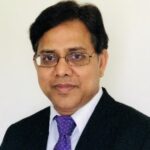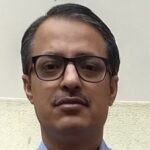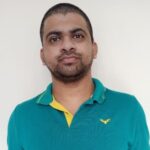| Day-1, 18-Dec-2021 | Day-2, 19-Dec-2021 | |
|---|---|---|
| 9:00 - 11:00 | Mobility Solutions for Visually Impaired in Unstructured Environments M. Balakrishnan Professor Emeritus Department of Computer Science & engineering Indian Institute of Technology Delhi INDIA | Memristors in Security Applications Chandan B. Samantaray Department of Engineering Virginia State University, VA, USA, 23806 |
| Tea break | ||
| 11:30- 13:30 | Automotive Radar – Trends for Assistive & Autonomous driving Anshu Gupta, Product Head Generation 6, Continental GT, India | Communication Perspectives of Smart Metering Anukram Mishra, Sohan Lal Purohit, and Bajrang Lal Genus Power Infrastructures Jaipur |
| Lunch break | ||
| 15:00 - 17:00 | V2X technology in Autonomous Vehicles Bibhay Ranjan Senior System Software Engineer NVIDIA, India | Information capture from Documents at Industrial Scale Peeta Basa Pati Department of CSE, Amrita Vishwa Vidyapeetham, Bengaluru, INDIA. |
Memristors in Security Applications
Chandan B. Samantaray
Department of Engineering
Virginia State University, VA, USA, 23806
Email: csamantaray@vsu.edu
Abstract :
There is a tremendous research effort is going on using memristive devices in security applications. Memristor is the fourth circuit element with a new architecture and design rule that provides hardware-, cyber-, and information- security applications on stochastic or chaotic circuits, physical unclonable functions (PUFs), and true random number generators (TRNGs). Due to the stochastic-switching behavior, memristors yield randomness which is the key to the cryptographic applications as well. Memristive cryptographic functions, specifically block ciphers that can encrypt data and provide its confidentiality. In case of smart devices, the random-switching behavior of memristor leads to ‘encryption’ and thus applied to the security applications. A true random number generator (TRNG) is a hardware component that generates a string of random bits, which can be used as a cryptographic key. The memristor-based random number generator or PUFs can be of great resource to both hardware- and cybersecurity applications.
Biography :

Chandan B. Samantaray, Ph.D. currently working as a faculty member in the Department of Engineering at the Virginia State University, VA, USA. Currently, his research focus is chaotic/stochastic memristor circuits, memristor based physical unclonable function (m-PUFs) and true random number generators (TNRG) for both hardware- and cybersecurity applications. Also, he has other active research area in neuromorphic/In-memory computing devices. He has several years of past research experience in the field of modern VLSI devices and emerging semiconductor memory including DRAM, NVRAM, RRAM, and CMOSFET.
Information capture from Documents at Industrial Scale
Peeta Basa Pati
Department of CSE, Amrita Vishwa Vidyapeetham, Bengaluru, INDIA.
Homepage : https://www.amrita.edu/faculty/peeta-pati, Email : pbp.iisc@gmail.com
Abstract :
Capturing information from documents is an important step in many processes. Organizations monetize the data & information captured from documents, server their customers efficiently and stay on top of their business. Document digitization is a multi-billion-dollar industry and is growing. Contrary to the belief that the volume of documents is reducing, it has grown by many folds over the last decade employing armies of people & bots. Technology builders are in the fore-front to deliver systems to automate these processes & reduce the cost of digitization.
Documents are either electronically generated or scanned. Technological components such as OCR, ICR, Barcode reader are utilized for scanned documents. Machine Learning models are used to make sense of document contents, capture business relevant information & deliver for downstream processing. Not only should a solution do the job, but it should integrate & operate in the ecosystem, perform at scale with cost effectiveness. The need of the hour is to provide data with a guarantee on its accuracy.
- This talk shall address the following:
- Intelligent document processing (IDP) systems, its components & expectations
- Document space and processing challenges
- Some prominent players in the space
- Issues with processing at scale, cost effectiveness, enablement & change management
Speaker Biography :

Dr. Peeta Basa Pati is a professor at Department of CSE, Amrita Vishwa Vidyapeetham, Bangalore. His research interests are in the field of document digitization and information capture. He has close to 20 years of experience in this field which includes 15+ years of industrial experience.
Prior to joining Amrita, Dr Pati was working at Cognizant Technology Solutions as a chief architect. In this role, he has built and managed IDP systems, implemented and successfully productionized IDP systems for multiple business domains and organizations. As part of this he has experience in dealing with documents which are structured as well as unstructured, type written & handwritten, dealing with documents with graphical information content.
Dr. Pati completed his Ph. D. & M. Sc. (Engg) from Indian Institute of Science, Bangalore and is an alumnus of NIT Rourkela. He has multiple publications and patents to his credit. He is a senior member of IEEE. He has delivered multiple tutorials in document processing area and has served in the program and technical committees of multiple national and international conferences, besides being a reviewer of papers for conferences and journals.
Automotive Radar – Trends for Assistive and Autonomous Driving
Anshu Gupta
Continental AG, India
anshu.gupta@continental-corporation.com
Abstract:
Today, every vehicle worldwide has an average of two sensors for Advanced Driver Assistance Systems (ADAS). These are usually cameras (front/surround view), radar (forward / backward-looking) or ultrasonic sensors. ADAS is not just a value-add today; it is also a critical aspect of vehicle safety. The intelligent sensors help us model the environment, analyze the situation, and make decisions to alert the driver or take necessary actions to prevent accidents. Radar is one of the cheaper ADAS sensors, plays a crucial role in enabling the future towards assisted and automated driving.
The session’s goal is to provide an in-depth view of automotive radar technology and market trends. Coming from an industry perspective, the presenter will try to declutter the current topic of the role of radar in assisted & autonomous driving. A comprehensive historical, technological progression will also be presented to appreciate how the automotive radar transforms itself from a luxury feature towards a commodity.
Speaker’s Bio:

Anshu Gupta, PhD is currently the global product head for the segment of next generation of high-volume radar business at Continental AG. He has deep experience in the design and development of automotive radars for Advanced Driving Assisted Systems (ADAS). He has a keen sense of market trends in the industry and has represented Continental at multiple international forums. He has around 10 years’ experience in engineering best value products for the next generation mobility solutions ranging from assisted to semi-autonomous driving for all major automotive OEMs in Asia, Europe & USA. He finished his PhD from University of the Federal Armed Forces, Hamburg, Germany and was the youngest graduate in the history of his department.
V2X Technology in Autonomous Vehicles
Bibhay Ranjan
NVIDIA, India
bibhayr@nvidia.com
Abstract:
The tutorial focuses on the V2X technology used in autonomous vehicles. V2X stands for Vehicle to Everyone. This is the technology that allows vehicles to communicate with moving parts of the traffic system around them. Also known as connected-vehicle-to-everything communication. V2X is 802.11p based wireless protocol. V2X has several subsets, including vehicle-to-vehicle communication (V2V) and vehicle-to-infrastructure (V2I). Though mainly used to increase safety, V2X also offers other benefits like enabling automatic payment of toll fees. V2X is instrumental in Non-Line of sight (NLoS), 360 degrees perceptions is Autonomous Vehicles. This technology has End-to-End latency of 20-500 ms, frequency up to 10 Hz, and range up to 1Km. Different countries have different Messaging standards, mainly CAM(EU), BSM(USA) and China (BSM). Vehicle-to-everything technology is expected to grow significantly over the next 20 years, as many top V2X suppliers, such as Delphi, Denso, Qualcomm, and Continental, have large-scale integration plans. Many new car models use some form of V2X technology, especially luxury brands. Vehicle-to-everything systems are expected to be added to lower-priced vehicles as well eventually.
Speaker’s Bio:

Bibhay is working with NVidia, India as Senior System Software Engineer. He is working in Hyderabad. Bibhay has received his Bachelor of Technology in Computer Science and Engineering, from National Institute of Technology, Warangal, India in 2012. Since then, he has been associated with Nvidia at various positions. During these years, Bibhay has worked on wireless technology including Wi-Fi and GPS for android, integrating new communication modules with the tegra SoC, optimizing latency on wireless communication. He also worked on Nvidia Wireless Game Controller (Wi-Fi based) host SW stack design and implementation. Bibhay has 2 patents approved and ready to be filed in 802.11 wireless technology.
Communication Perspectives of Smart Metering
Anukram Mishra, Sohan Lal Purohit and Bajrang Lal
Genus Power Infrastructures Jaipur
anukram.mishra@genus.in, sohan.purohit@genus.in, bajrang.agarwal@genus.in
Abstract: Smart metering revolution has finally taken off in India. As it happened in other countries, a strong government mandate has fuelled its acceleration. Gazette of India, in its recent notification released on 19th August 2021 sets the deadline of Dec 2025 to cover 100% consumers with smart meters in prepayment mode. The main stakeholders in the smart metering program are utilities (DISCOMS), government agencies (such as regulatory bodies, Central Electricity Authority) and last but not least are the electricity consumers. Other than an overall figure of about 25% AT&C losses, there are other compelling drivers for smart metering; Global energy carbon footprint has risen 30% in last 25 years, making Energy Efficiency (EE) a very important subject for the planet. Investment in national infrastructure is a serious subject and questions related to scalability, reliability, security and future-proofing need to be addressed and provisioned for. In this tutorial we would focus on smart metering system, communication technologies, and distribution transformer and sub-station metering. Ratification of Indian Standard (IS 16444) for smart meters had been a great enabler in this mission. Salient features of open (International) data exchange protocols between different AMI devices would also be covered.
Keywords: AMI, Energy Efficiency, Integration of Renewables, NBIoT, e-SIM, IPv6, IoT, Cellular, RF Mesh, DLMS-COSEM
Biography of Speakers
Anukram Mishra

Anukram Mishra has over 34 years of experience in corporate- starting with 7 years in Inertial Navigation and Attack Systems, HAL. He possesses over 27 years of experience of working in Metering Solutions, Smart Meters, Communication Technologies for AMI, Smart Grid at Genus Power Infrastructure, Jaipur & Landis+Gyr Global Development Centre, Noida. He is currently Chief Technology Officer, Metering Solutions Division of Genus Power Infrastructure Ltd. at Jaipur. He earned B.Tech. from MBM Jodhpur, Masters from IIT Madras and Ph.D. in ‘Constrained Bandwidth AMI’ from MNIT, Jaipur, INDIA.
Sohan Lal Purohit

Sohan Lal Purohit is currently working as Chief Manager, Precision Metering, Metering Solutions Division of Genus Power Infrastructure Ltd. at Jaipur. In his career of 18 years, he has worked for 2 years initially as Product Engineering Technical Specialist at iGate, Noida. He is working at current organization for past 14 years with extensive experience in Metering Solutions, Smart Meters, High end meters, Communication Technologies for Advanced Metering Infrastructure, Smart Grid. He has also worked at other organizations Secure Meters, Udaipur & Landis + Gyr, Noida. He earned his B.Tech. in 2003 from MNIT Jaipur INDIA.
Bajrang Lal

Bajrang Lal is currently working as Chief Manager, Subject Matter Expert (Firmware), Metering Solutions Division of Genus Power Infrastructure Ltd. at Jaipur. He possesses over 18 years of experience in Metering Solutions, Smart Meters, High end meters, Communication Technologies for Advanced Metering Infrastructure, Smart Grid. He earned his B.Tech. in 2003 from MNIT Jaipur INDIA. He is member of BIS (Bureau of Indian Standards), ETD13 committee, which works on National Standards for electrical energy measurement and load control
Mobility Solutions for Visually Impaired in Unstructured Environments
M. Balakrishnan
Professor Emeritus
Department of Computer Science & engineering
Indian Institute of Technology Delhi INDIA
mbala@cse.iitd.ac.in
Abstract:
In this talk we present the work of ASSISTECH, IIT Delhi in developing mobility solutions aimed at independent mobility of visually impaired in low income countries like India. ASSISTECH has had some success in disseminating the technology solutions that have been developed in the laboratory. First, we would focus on uniqueness of our context and how these solutions innovatively address our needs including affordability. Further, we also talk about the challenges in translational research and dissemination that is critical for taking any proof-of-concept beyond the walls of a laboratory. The key take away from this lecture would be the importance of inter-disciplinary research as well as intense engagement with users in the complete life-cycle of the project. Apart from the solutions that have gone out of the lab, we also briefly present some of our ongoing research in this space.
Biography:

M. Balakrishnan is a Professor in the Department of Computer Science & Engineering, IIT Delhi. He obtained his B.E.(Hons.) in Electronics & Electrical Engg. from BITS Pilani in 1977 and Ph.D. from EE Dept. IIT Delhi in 1985. He worked as a Scientist in CARE, IIT Delhi from 1977 to 1985 where he was involved in designing and implementing real-time DSP systems. For the last 33 years, he is involved in teaching and research in the areas of digital systems design, electronic design automation and embedded systems. He has supervised 16 Ph.D. students, 3 MSR students, nearly 200 M.Tech/B.Tech projects and published nearly 130 conference and journal papers. ASSISTECH, a laboratory and research group founded by him along with Prof. P.V.M. Rao (Mech Engg), is involved in developing a number of assistive devices targeted towards mobility and education of the visually impaired. SmartCaneTM is a mobility aid for visually impaired developed by his group which is currently used by tens of thousands of users in India and other low-income countries. He has been a recipient of three National awards, ACM Eugene L Lawler award and very recently IIT Delhi’s Life Time award for his work in the disability space.